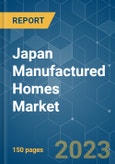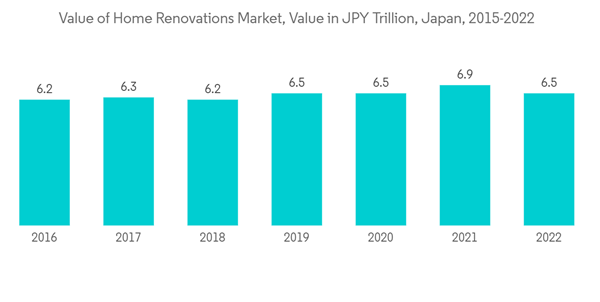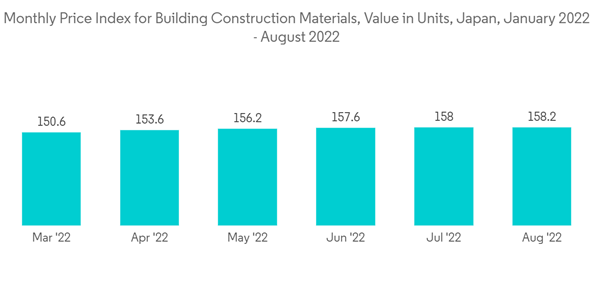The size of Japan manufactured homes market is USD 4.3 billion in the current year and is anticipated to register a CAGR of over 4% during the forecast period.
Moreover, unlike other countries, homes in Japan rapidly depreciate over time, and they become nearly valued less within 20 to 30 years of their lifetime. The aged homes in the country are either demolished or renovated based on their condition. In order to avoid higher investment in conventional constructions, the Japanese are considering manufactured structures as the best alternative to replace traditional homes.
Meanwhile, prefab homes are also witnessing significant growth in the country. The changing demographic trends in Japan give the citizens a reason to rehab their old homes, which is driving the adoption of manufactured prefab panels as a second skin to the old buildings. In addition, in 2021, as per the Ministry of Internal Affairs and Communications survey, the home renovation market in Japan stood at JPY 6.9 trillion (USD 0.051 trillion), up from JPY 6.5 trillion (USD 0.048 trillion) in the previous year. Thus, the growing aged structures are driving the manufactured homes market in the country.
Moreover, due to the Russia-Ukraine war, Japanese construction companies have halted orders for Russian wood. In addition, as per real estate experts, the soaring construction materials prices further lead to the trend of rising home prices. Also, the cost of home construction is expected to rise by nearly 5 to 10% in the future, as building material prices keep soaring. Thus, the growing construction costs accelerate the growth of manufactured home adoption in the country.
However, in 2021, the average price index of cement for construction in Tokyo stood at 104.9 index points, which was higher than the pre-pandemic levels. Meanwhile, in 2022, material prices for building construction peaked at 158.2 points in August.
Key Highlights
- COVID-19 slightly impacted the manufactured homes market in Japan. Due to COVID-19 restrictions, many construction projects were delayed or canceled. In addition, the pandemic disrupted all manufacturing supply chains, but that did not last long. Moreover, the pandemic resulted in a labor and building materials shortage, leading to increased construction costs by 5% to 10%. After easing restrictions, the construction of manufactured homes witnessed significant growth.
- Moreover, Japan’s manufactured housing industry is leading in terms of innovation, with efficient production processes, targeted marketing strategies and consumer outreach, and high-quality designs that offer variability and flexibility at affordable prices. In addition, manufactured home developers provide a fully computerized system to their clients to offer customized homes with standardized components.
- Meanwhile, the Japanese prefer factory-manufactured houses when compared to conventionally built ones. However, Japan’s population is declining and is expected to decrease by nearly 40 million by 2065. In addition, the country also has an aging population, with more than one-third of people in Japan will be over the age of 65 in the coming years. These factors are causing an above-average number of homes to be vacant. Furthermore, the low life cycle of Japanese homes is driving the manufactured homes industry in the country.
Japan Manufactured Homes Market Trends
Manufactured Homes are Witnessing a Rise in Adoption
The Japanese manufactured homes industry is innovative and has developed a user-orientated approach by integrating specially developed marketing, design, and quality-orientated techniques into its production processes. In order to meet the growing demand for manufactured homes, the industry offers customized products through integrated management and proper utilization of standard products as well as the flexibility of assembly options.Moreover, unlike other countries, homes in Japan rapidly depreciate over time, and they become nearly valued less within 20 to 30 years of their lifetime. The aged homes in the country are either demolished or renovated based on their condition. In order to avoid higher investment in conventional constructions, the Japanese are considering manufactured structures as the best alternative to replace traditional homes.
Meanwhile, prefab homes are also witnessing significant growth in the country. The changing demographic trends in Japan give the citizens a reason to rehab their old homes, which is driving the adoption of manufactured prefab panels as a second skin to the old buildings. In addition, in 2021, as per the Ministry of Internal Affairs and Communications survey, the home renovation market in Japan stood at JPY 6.9 trillion (USD 0.051 trillion), up from JPY 6.5 trillion (USD 0.048 trillion) in the previous year. Thus, the growing aged structures are driving the manufactured homes market in the country.
Increasing Construction Costs Drive the Market Growth
Currently, most developers are utilizing wood in constructing residential units in Japan. In 2021, Japan witnessed a rise in buildings constructed from wood materials. Whereas in 2022, timber prices surged to record highs in Japan since economic sanctions were imposed against Russia, further leading to increasing housing costs in the years ahead. In addition, more than 80% of the timber is imported from Russia, which includes wood veneer sheets to make plywood boards, highly utilized in building constructions.Moreover, due to the Russia-Ukraine war, Japanese construction companies have halted orders for Russian wood. In addition, as per real estate experts, the soaring construction materials prices further lead to the trend of rising home prices. Also, the cost of home construction is expected to rise by nearly 5 to 10% in the future, as building material prices keep soaring. Thus, the growing construction costs accelerate the growth of manufactured home adoption in the country.
However, in 2021, the average price index of cement for construction in Tokyo stood at 104.9 index points, which was higher than the pre-pandemic levels. Meanwhile, in 2022, material prices for building construction peaked at 158.2 points in August.
Japan Manufactured Homes Market Competitor Analysis
The report covers major players operating in Japan manufactured homes market. The market is highly competitive and fragmented in nature, with none of the players occupying the major share. To remain competitive in the market the major players in the market are constantly working to enhance their product offerings to meet the changing needs of the manufactured homes market. Some of the major players in the market include Toyota Housing Corporation, Asahi Kasei Homes Corporation, Misawa Homes Co., Ltd., Shimizu Corporation, etc.Additional Benefits:
- The market estimate (ME) sheet in Excel format
- 3 months of analyst support
Table of Contents
1 INTRODUCTION
2 RESEARCH METHODOLOGY
4 MARKET INSIGHTS
5 MARKET DYNAMICS
6 MARKET SEGMENTATION
7 COMPETITIVE LANDSCAPE
Companies Mentioned (Partial List)
A selection of companies mentioned in this report includes, but is not limited to:
- Sekisui House, LTD
- DTH Prefab
- Daiwa House Group
- Panasonic Homes Co., Ltd.
- Toyota Housing Corporation
- Sanyo Homes Co., Ltd.
- Shimizu Corporation
- Asahi Kasei Homes Corporation
- Taisei Housing Corporation
- Misawa Homes CO.,LTD.
- Hinokiya Resco Co., Ltd.
Methodology

LOADING...










